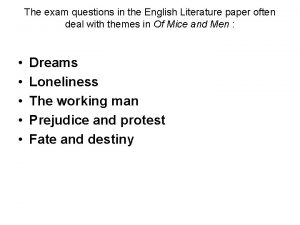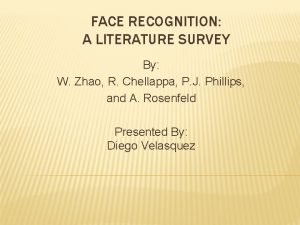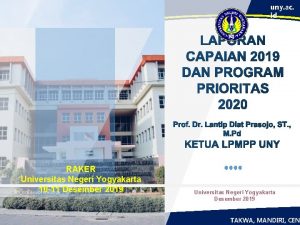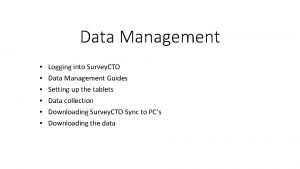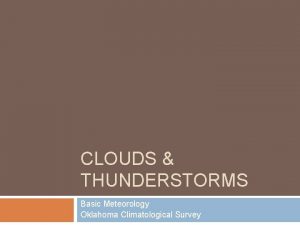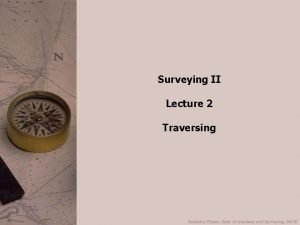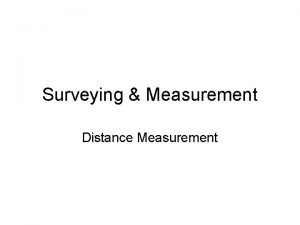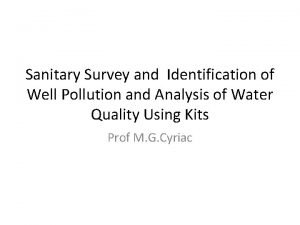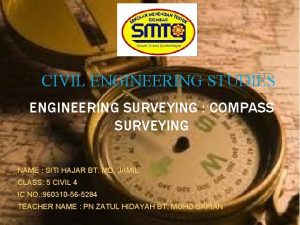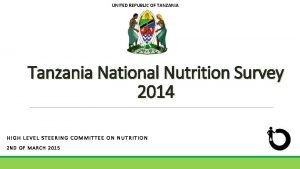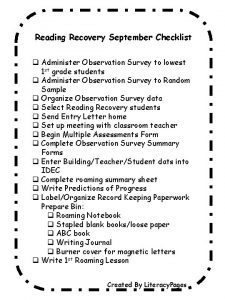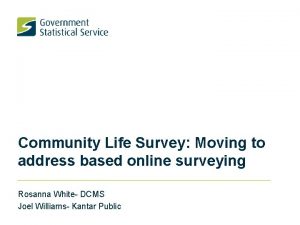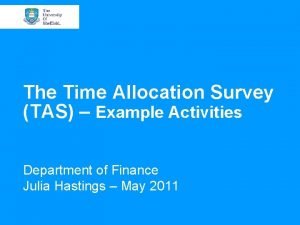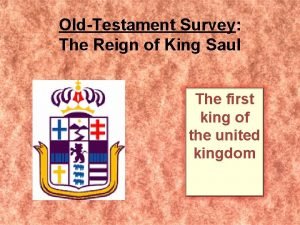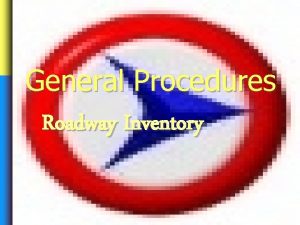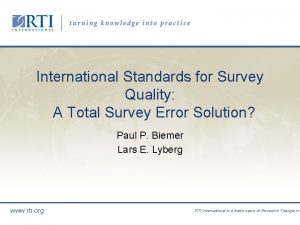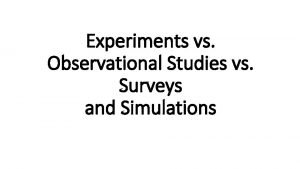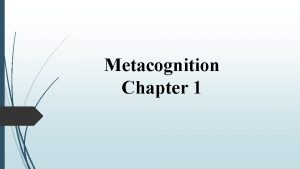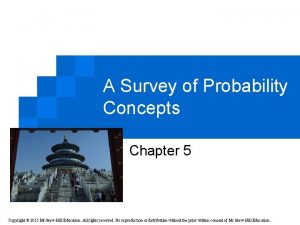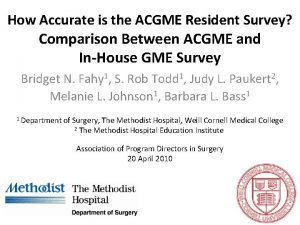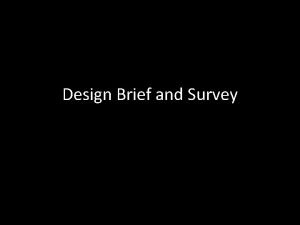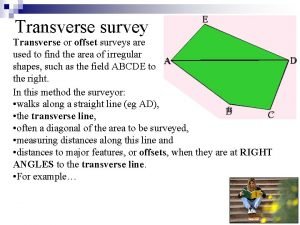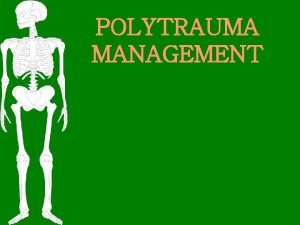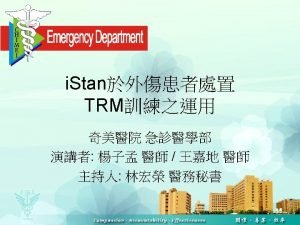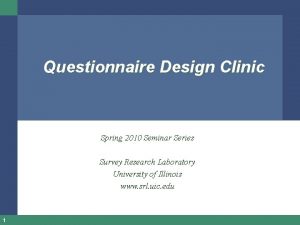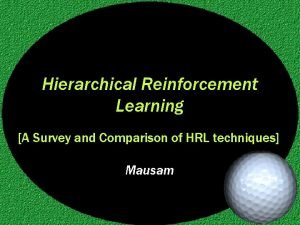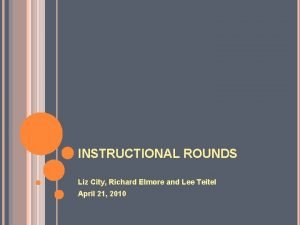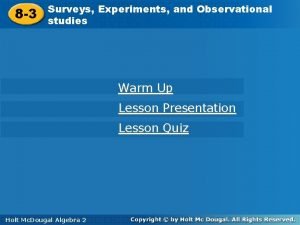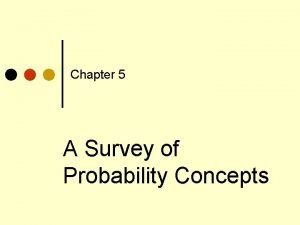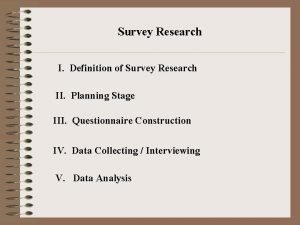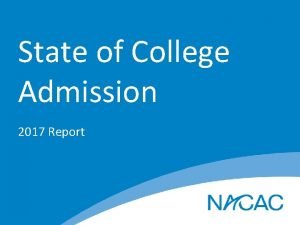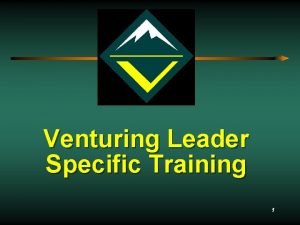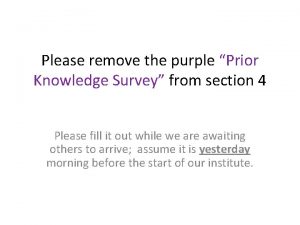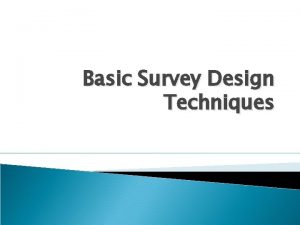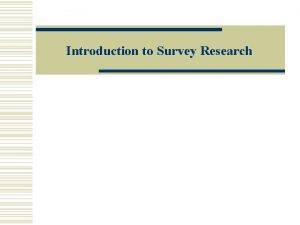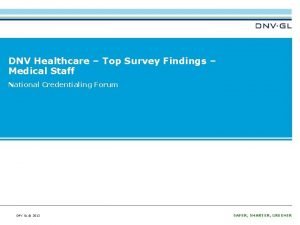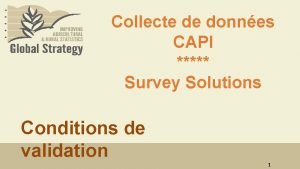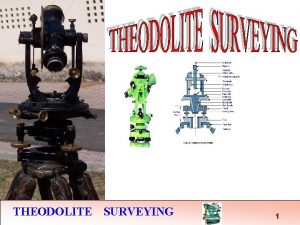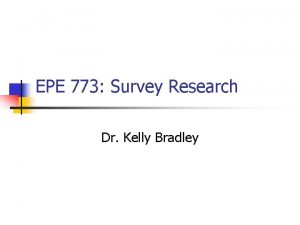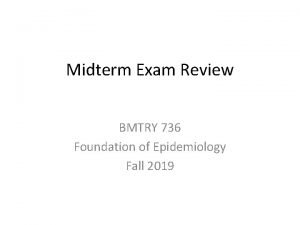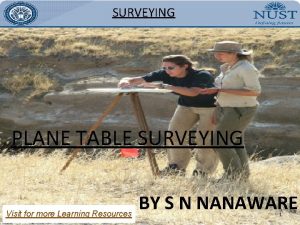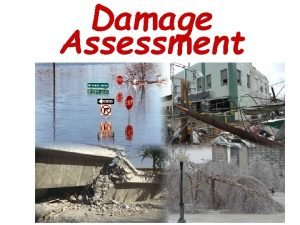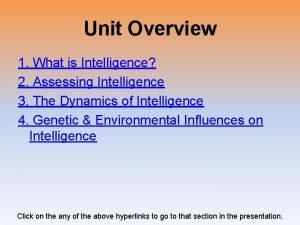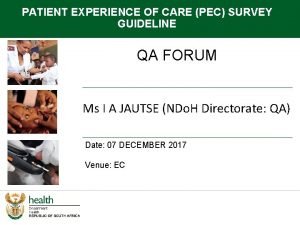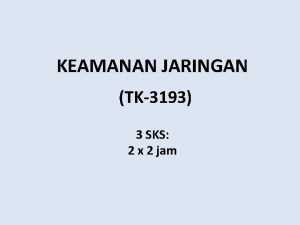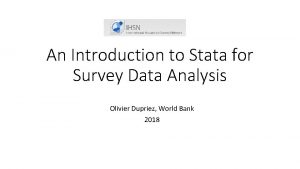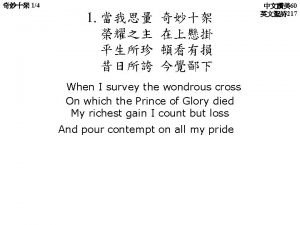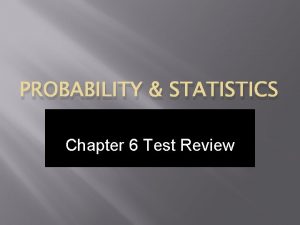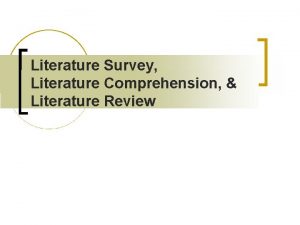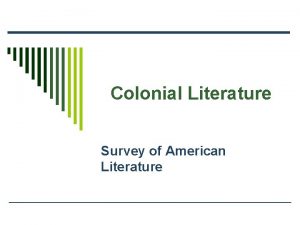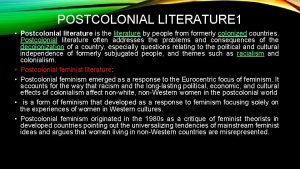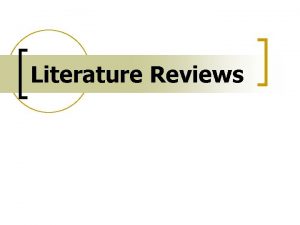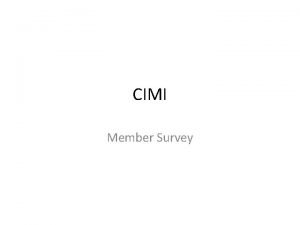Literature Survey What is Literature Survey A literature







![2 D Tactile Display Technology Survey Reference [1] "A new dynamic tactile display for 2 D Tactile Display Technology Survey Reference [1] "A new dynamic tactile display for](https://slidetodoc.com/presentation_image_h2/93630acc266f6e27e6556978b1d6c0e3/image-8.jpg)

















































































- Slides: 89

Literature Survey

What is Literature Survey? • A literature survey is the effective evaluation and critical synthesis of previous research on a research topic • The purpose of a survey is to analyze critically a segment of a published body of knowledge through summary, classification, and comparison of prior research studies, reviews of literature, and theoretical articles • The evaluation of the literature leads logically to the research question • A survey may form a preface to and rationale for engaging in primary research process or may constitute a research project in itself

Creating a Literature Survey • Step 1: Search sources Use internet, library and other possible medias to find literature sources. Keyword, category and author searches are effective tools. Use hyperlinks to broaden and deepen your search. • Step 2: Filter information Browse through the collected sources, read the abstracts, and select the ones relevant to your research field. Searching and filtering are iterative processes. The process leads to better understanding of your research field. • Step 3: Create a summary Recap the important information and state the essences of the sources relevant to your research. It might trace the research progression of the field. • Step 4: Create a synthesis Re-organize the information in a meaningful way, sometimes across the sources. Evaluate the sources, analyze the strengths and limitations of the research, and advise the readers on the most pertinent or relevant.

Good & Poor Literature Survey

Citing the Internet Source Project 1 Frontiers in Robotic Research Literature Review Topic: (Your research topic) Group XX: (Names of group members) Date: September xx, 2018 • Basic Info Retrieve date Web address Source Stefan Williams (February 18, 2013) “Introduction Video Autonomous Underwater Vehicle”, You. Tube. Retrieved, 9/18/2012, http: //www. youtube. com/watch? v=Mjl. ORkp. D 33 E Author(s) Date created Title This video introduces two major types of Autonomous Underwater Vehicles. Both are similar in the clear imaging data, however; they are used for different purposes. The larger AUV is designed for low-speed, near bottom operation. It contains sensor that can detect many aspects of the ocean. The smaller vehicle is torpedo shaped. It is designed for lower speed operation. It is recently used to map out the submerged Neolithic city near the coast of Greece. The city is 3500 old and under 2 -4 meters of water. Summary

Citing the Technical Paper Source Publish date • Bruce Banter, “Touch Screens and Touch Surfaces are Enriched by Haptic Force-Feedback”, Information Display 3/10, March 2010 (pp. 26 -30). Author(s) Title Page numbers

2 D Tactile Display Technology Survey Tactile Display Examples Piezoelectric Shape Memory Alloy (SMA) Servo Motor Solenoid Pneumatic
![2 D Tactile Display Technology Survey Reference 1 A new dynamic tactile display for 2 D Tactile Display Technology Survey Reference [1] "A new dynamic tactile display for](https://slidetodoc.com/presentation_image_h2/93630acc266f6e27e6556978b1d6c0e3/image-8.jpg)
2 D Tactile Display Technology Survey Reference [1] "A new dynamic tactile display for reconfigurable braille- implementation and tests", Paolo Motto Ros, Vittorio Dante, Luca Mesin, Erminio Petetti, Paolo Del Giudice and Eros Pasero, Frontiers in Neuroengineering, 2014. [2] "Tactile display using shape memory alloy micro-coil actuator and magnetic latch mechanism", T. Matsunaga a, K. Totsu, M. Esashi, Y. Haga, 2013. [3] "Actuation mechanism for high-resolution tactile display", Nakashige Mutsuhiro, Hirota Koichi and Hirose Michitaka, 2004. [4] "A Thermopneumatic Approach for Tactile Displays", Fernando Vidal-Verdú and Rafael Navas-González, 2004. [5] "VITAL: An electromagnetic integrated tactile display", Mohamed Benali-Khoudja, Moustapha Hafez, Abderrahmane Kheddar, 20107. [6] "The Shape of Things to Come: Pin-Based Tactile Shape Displays", Robert D. Howe, 2004. [7] "Development of Soft-Actuator-Based Wearable Tactile Display", Ig Mo Koo, Kwangmok Jung, Ja Choon Koo, Jae-Do Nam, Young Kwan Lee, and Hyouk Ryeol Choi, 2008. [8] "Tactus White Paper", 2013. [9] "A Microfabricated Electrostatic Haptic Display for Persons with Visual Impairments", Hui Tang and David J. Beebe, 1998. [10] Senseg company website: http: //senseg. com/experience/senseg-technology [11] "Vibrotactile Display: Perception, Technology, and Applications", Seungmoon Choi, and Katherine J. Kuchenbecker, 2013. [12] "Noncontact Tactile Display Based on Radiation Pressure of Airborne Ultrasound", Takayuki Hoshi, Masafumi Takahashi, Takayuki Iwamoto, and Hiroyuki Shinoda, 2010. [13] "Electrotactile Display of Computer Graphics for Blind", Kurt Kaczmarek, 2004. [14] "A Thermal Tactile Display Device with Multiple Heat Sources", Mao Zhipeng, Wu Jianfeng, Li Jianqing, Zhou Lianjie, Li Xiaomin, Yang Yurong, 2012.

2 D Tactile Display Technology Survey Indentation – Array of pins actuated by / array of bumps raised by …… Technology Size Resolution Piezoelectric cntr-to-cntr: 1. 5 mm 8 x 8 pin diameter: 0. 8 mm pin gap: 0. 7 mm Height Refresh Rate Strength 1. 0 mm 50 Hz mature technology, natural, high freq. , low power Shape Memory cntr-to-cntr: 1. 27 mm 10 x 10 2. 0 mm Alloy (SMA ) cntr-to-cntr: 2. 5 mm 3. 3 Hz natural, easy to control Weakness complex mechanic, small displacement, high voltage (200 V) complex mechanical arrangement, structural/functional fatigue Inte. Cost gration L H Pneumatic cntr-to-cntr: 2. 0 mm 10 x 10 pin diameter: 0. 5 mm 0. 6 mm gap btw pins: 1. 5 mm 1/60 Hz natural, lower cost slow response time L M Thermopneumatic 4 x 4 cntr-to-cntr: 2. 54 mm 1. 0 mm rise: 2 s fall: 11 s natural, lower cost slow response time, high power consumption L L Solenoid cntr-to-cntr: 5. 0 mm 8 x 8 pin diameter: 2. 0 mm 0. 1 mm gap btw pins: 3. 0 mm natural, use mature PCB technology complex mechanical manufacturing process L M complex mechanical arrangement, hard to pack densely L H natural, wearable high voltage safety M H natural, easily integrated into mobile devices slow response time H H Servo Motor 6 x 6 cntr-to-cntr: 2. 0 mm Electroactive Polymer (EAP) 4 x 5 Microfluidic Keyboard 2. 0 mm cntr-to-cntr: 3. 0 mm pin diameter: 2. 0 mm 0. 5 mm gap btw pins: 1. 0 mm N/A 800 Hz 7. 5 Hz (2. 0 mm), natural, simple, 20 Hz (low mature technology deflection) 150 Hz N/A

2 D Tactile Display Technology Survey Non-indentation – through electrovibration / mechanical vibration Technology Size Resolution Height Refresh Rate cntr-to-cntr: 2. 54 mm Electrovibration 7 x 7 pad diameter: 1. 78 mm with Wafer gap btw pins: 0. 76 mm 0. 0 mm N/A, high Electrovibration 1 x 1 with ITO Film N/A 0. 0 mm N/A, high Vibrotactile N/A 0. 0 mm N/A, high N/A Ultrasound 1 x 1 18 x 18 total area 180 x 180 mm 2 Strength variety of effects no moving parts simple (electrodes & software) simple, mature tech no mechanical contact sense 3 D object Weakness Inte. Cost gration high voltage safety needs relative motion M L high voltage safety needs relative motion H L no multi-touch H L limited resolution L H Non-indentation – through electrical & thermal …… Technology Electrotactile Thermal Size Resolution Height Refresh Rate cntr-to-cntr: 2. 3 mm 24 x 24 pad diameter: 0. 89 mm gap btw pins: 1. 41 mm 3 x 3 total area: 38 x 38 mm 2 0. 0 mm N/A Strength Weakness Inte. Cost gration variety of effects no moving parts simple (electrodes & software) high voltage safety resistive heating effect M L realistic sensation localization sensitivity is low for low intensity of heat M L

2 D Tactile Display Technology Survey • Observations – Indentation is the most popular method due to its similarity to Braille – Most of the pin array implementations are very complex & expensive – Most implementations are only designed for fingertip tactile feedback – Graphic display needs double resolution than Braille display – Thermal solutions consume more power – Pneumatic solutions are slow – No PCB implementation for electrovibration • Most Promising Technologies – Electroactive Polymer (EAP) – Microfluidic – Electrovibration-PCB Metec Hyper. Braille (120 x 60, Piezoelectric, $90, 000, > 20 lb)



Literature Survey Technical papers Patents Product websites

Technical Papers

Technical Papers Structure of Technical Papers • Abstract • Introduction • Methods • Results • Discussion/Conclusion

Technical Papers – Abstract • Purpose – Summarize article accurately – Includes objective/research question, methods, results, conclusion • Highlight Findings • Available Free – Assists reader to decide if worth reading article – Key words used in electronic literature searches * Reference list includes only articles that are read completely, not based on the abstract

Technical Papers – Introduction • Review of literature • Theory • Research question(s) • Purpose of study

Technical Papers – Methods • Setting/procedures • Instruments/equipment • Design • Implementation/experiments • Data collection

Technical Papers – Results • Analyses conducted • Results of analyses • Significance of results • Answers to the research questions/hypotheses

Technical Papers – Discussion • Summary of findings • Interpretation of findings • Relationship of findings to other studies • Strengths and contribution of study • Limitations of findings • Generalize results • Weakness of study • Application implications of findings • Further studies

Non-Patent Documents Internet Searches (Google, Yahoo, etc. ) Trade Publications and Databases ACM Digital Library (http: //dl. acm. org) IEEE Xplore Digital Library (http: //ieeexplore. ieee. org/Xplore/home. jsp) CHEMnet. BASE (http: //www. chemnetbase. com) Mechanical. Engineeringnet. BASE (http: //www. crcnetbase. com/page/mechanical_engineering_ebooks)

Patents

What is a Patent? A patent is an intellectual property right granted by the Government of the United States of America to an inventor “to exclude others from making, using, offering for sale, or selling the invention throughout the United States or importing the invention into the United States” for a limited time in exchange for public disclosure of the invention when the patent is granted.

What is a Patent? An exclusive right A right by statue/law A territorial right A time limited right

Global Innovation Index 2014

Types of Patents Utility patents – 20 years from filing date Design patents – 14 years from date granted Plant patents – 20 years from filing date 6% PGPubs (Pre-Grant Publications) 5% Design Utility Design PGPub 87% Utility Plant, Reissue, Misc.

Utility. Patents Utility – any new and useful process, machine, article of manufacture, or composition of matter, or any new and useful improvement thereof Example: US 5348340 A, Air bag assembly for motor vehicles

Design Patents Design – a new, original, and ornamental design for an article of manufacture Example: US D 457, 884, Computer Mouse

Plant Patents Plant – discovers and asexually reproduces any distinct and new variety of plant Example: US 6583335 B 1, Transformation of onion plants; obtain plant cell, transform with vector, recover transformed cells, propagate embryo

Criteria of Patentability Innovativeness (Novelty) Industrial Utility (Usefulness) Inventive Step (Non-obviousness) Novelty Utility Nonobviousness

Criteria of Patentability Innovativeness (Novelty) Must not be known or used by others in this country Or patented or described in a printed publication in this or a foreign country Novelty Utility Nonobviousness

Criteria of Patentability Industrial Utility (Usefulness) subject matter has a useful purpose and also includes operativeness Invention must "work" to be useful Novelty Utility Nonobviousness

Criteria of Patentability Inventive Step (Non-obviousness) The subject matter sought to be patented must be sufficiently different from what has been used or described before that it may be said to be nonobvious to a person having ordinary skill in the area of technology related to the invention Novelty Utility Nonobviousness

Why Patent Search? To see if any Prior Art similar to your invention exists Helps determine if you want to file an application Helps to determine the appropriate claim scope Understand competition/competitor tracking Avoid patent infringement Technology tracking/Your field of invention Find market information

What is Prior Art All information that has been disclosed to the public in any form about an invention before a given date

Examples of Prior Art Patents Books Trade Shows Prior Art Trade or Professional Journals Government Documents Product Bruchures

Patent Documents Patent Office Websites United States Patent and Trademark Office (USPTO) (http: //www. uspto. gov) European Patent Office (EPO) (http: //ep. espacenet. com) Japan Patent Office (JPO) (http: //www. jpo. go. jp) Korean Intellectual Property Rights Information Service (KIPRIS) (http: //www. kipris. or. kr/enghome/main. jsp) State Intellectual Property Office of the R. P. C. (http: //english. sipo. gov. cn/) World Intellectual Property Organization (WIPO) (http: //www. wipo. int) Free Patent Search Tools Google Patent Search (http: //www. google. com/? tbm=pts) Free Patents Online (http: //www. freepatentsonline. com)

Basic Parts of a Patent Title Patent number Inventor Issue date Filing date Application number U. S. class International class Field of search Reference cited Abstract Drawings Field of invention Summary Background Description of drawings Detailed Description Claims

Basic Parts of a Patent no. Issue date Title Inventor(s) Application no. Filing date International class U. S. class Field of search Reference cited Abstract Drawings Field of invention Background Summary Description of drawings Detailed Description Claims Reference cited

Basic Parts of a Patent no. Issue date Title Inventor(s) Application no. Filing date International class U. S. class Field of search Reference cited Abstract Drawings Field of invention Background Summary Description of drawings Detailed Description Claims

Basic Parts of a Patent no. Issue date Title Inventor(s) Application no. Filing date International class U. S. class Field of search Reference cited Abstract Drawings Field of invention Background Summary Description of drawings Detailed Description Claims

U. S. Patent Classification (USPC) A patent examiner based on USPC to review when examining patent applications Hierarchical Structure US Class: Classes/Subclasses (e. g. 280/213) 460+ classes and 150, 000+ subclasses

Classes 307 310 312 313 314 315 318 320 322 323 324 326 Electrical transmission or interconnection systems Electrical generator or motor structure Supports: cabinet structure Electric lamp and discharge devices: consumable electrodes Electric lamp and discharge devices: systems Electricity: motive power systems Electricity: battery or capacitor charging or discharging Electricity: single generator systems Electricity: power supply or regulation systems Electricity: measuring and testing Electronic digital logic circuitry

Subclasses 301 Nuclear reaction 302 Contact potential difference 303 P-N semiconductor 304 Secondary electron emission 305 Direct charge particle emission 306 Thermal or pyromagnetic 307 With heat actuated bimetal element 308 Charge accumulating 309 Electrostatic 310 Friction

Schedule of Subclasses 310. . . Friction: This subclass is indented under subclass 309. Subject matter in which the static electricity is generated by frictional moving contact of two parts of the apparatus. SEE OR SEARCH CLASS: 361, Electricity: Electrical Systems and Devices, subclass 207 for electrostatic electric relay systems such as those which utilize the Winslow effect, which is defined in the definition of that subclass.

Cooperative Patent Classification (CPC) A joint partnership between the USPTO and the EPO to harmonize existing systems (ECLA and USPC, respectively) Ensure compliance with the International Patent Classification system (IPC) standards administered by the World Intellectual Property Organization (WIPO) CPC has been in force since 1 January 2013 EPO now classifies its documentation using the CPC only From 2015 onwards, the USPTO will classify exclusively in the CPC (except for plants and designs) CPC website: www. cpcinfo. org

CPC Classification Structure Hierarchical Levels Sections Classes Subclass Class Subclass Groups Subgroups Classification Scheme Group syntax Notes and Reference Group Subgroup Group

CPC Sections ► Sections: 8 Sections 49

Format of CPC Symbols A 23 G 9/0202 ► complete group symbol; consists of different components A A 23 G 9/00 A 23 G 9/0202 Section (A, B, . . . H) Class (any 2 digits) Subclass (any letter) Main Group Subgroup Note: Documents are classified with main group and/or subgroup symbols 50 50

CPC Symbols Example of a CPC classification symbol C 07 D 203/00 Main Group (always /00) or Section 203/0214 Subgroup Class Subclass Group 51 51

Cooperative Patent Classification (CPC)

7 -Step Patent Search Strategy Classification • • Step 1 - Brainstorm Keywords Step 2 - Determine the Initial Classification Step 3 - Verify Relevancy Step 4 - Read Classification Definitions Access Full Text • Step 5 – Search Issued Patents and Published Applications Review & Reference • Step 6 - Review Claims, Specifications and Drawings • Step 7 - Check All References

Step 1: Brainstorm Begin with alphabetical listing of technical and common terms Look for terms describing the invention and its purpose, function, effect, process, end-product, structure, material, and use Example: Bicycle Sail

Step 2: Determine Initial Classification Start with United States Patent and Trademark Office (USPTO) website: http: //www. uspto. gov/, and click Patents link Click Patent Classification menu item on the left Select Browse Index to USPC submenu item Select B and looking for Bicycle Identify and click Class Number 280 for Bicycle

Step 2: Determine Initial Classification

Step 2: Determine Initial Classification

Step 2: Determine Initial Classification

Step 2: Determine Initial Classification

Step 2: Determine Initial Classification

Step 2: Determine Initial Classification

Step 2: Determine Initial Classification

Step 3: Verify Relevancy Click Class 280 to read Class Definition Search for Sail and found Subclass Sail Attachment with Subclass Number 213

Step 3: Verify Relevancy

Step 3: Verify Relevancy

Step 3: Verify Relevancy

Step 4: Read Classification Definitions Click 213 for Subclass Definition Click Sail Attachment for Subclass Hierarchy and Definition

Step 4: Read Classification Definitions

Step 4: Read Classification Definitions

Step 4: Read Classification Definitions

Step 4: Read Classification Definitions

Step 4: Read Classification Definitions

Step 5: Review Published Applications and Patents in Selected Subclasses Click A icon for pre-granted Patent Applications Click Published Application Number or Title to see Application Abstract Click Images to see Application Image Click P icon for granted Patents Click Patent Number or Title to see Patent Abstract Click Images to see Patent Image

Step 5: Review Published Applications and Patents in Selected Subclasses

Step 5: Review Published Applications and Patents in Selected Subclasses.

Step 5: Review Published Applications and Patents in Selected Subclasses.

Step 5: Review Published Applications and Patents in Selected Subclasses.

Step 5: Review Published Applications and Patents in Selected Subclasses.

Step 5: Review Published Applications and Patents in Selected Subclasses.

Step 5: Review Published Applications and Patents in Selected Subclasses.

Step 5: Review Published Applications and Patents in Selected Subclasses.

Step 6: Review Specifications, Claims and Drawings Review Patent Specifications Background Summary Brief Description Review Patent Drawings Review Patent Claims

Step 6: Review Specifications, Claims and Drawings

Step 6: Review Specifications, Claims and Drawings

Step 7: Check Patent References Review References Cited provided by the applicant and patent examiner Review Additional Classifications Review Forward Citation Search links Patents that cite the current patent

Step 7: Check Patent References Reference cited

Step 7: Check Patent References

America Invents Act (AIA) New 35 U. S. C. § 102(a)-(d) substantially changes basis for novelty First-to-Invent System became First-Inventor-to-File Effective March 16, 2013 Broadens prior art to also include experimental uses and oral presentations

Action Items • Refine your literature survey (including technical papers, patent search, and product websites) based on what we have learned today • Create a summary and synthesis literature survey report • Due day: 10/31/2016, Monday
 Abcd of acls
Abcd of acls Survey the literature
Survey the literature Survey of english literature exam questions
Survey of english literature exam questions Face recognition a literature survey
Face recognition a literature survey Survey e monev uny
Survey e monev uny Redcap survey distribution tools
Redcap survey distribution tools Bax summer camp
Bax summer camp Origin and destination survey
Origin and destination survey Survey cto
Survey cto Descriptive survey design
Descriptive survey design Oklahoma climatological survey
Oklahoma climatological survey Lines traverse
Lines traverse Taping surveying
Taping surveying Acgme resident survey
Acgme resident survey Global transfer pricing survey
Global transfer pricing survey Sanitary survey
Sanitary survey Compass principle
Compass principle Great britain tourism survey
Great britain tourism survey Tanzania national nutrition survey 2019
Tanzania national nutrition survey 2019 Employee survey action planning process
Employee survey action planning process Observation survey summary sheet examples
Observation survey summary sheet examples Value line investment survey
Value line investment survey Facilitator feedback survey
Facilitator feedback survey Community life survey
Community life survey Time allocation survey
Time allocation survey Survey reign rising
Survey reign rising Road inventory survey meaning
Road inventory survey meaning International quanity survey
International quanity survey Observational study vs survey
Observational study vs survey European working conditions survey
European working conditions survey Zoomerang survey
Zoomerang survey Active voice survey
Active voice survey Skimming reading clipart
Skimming reading clipart Study habits questionnaire with interpretation
Study habits questionnaire with interpretation General multiplication rule
General multiplication rule Acgme resident survey
Acgme resident survey Survey layout
Survey layout Offset in survey
Offset in survey Openended questions
Openended questions Polytrauma slideshare
Polytrauma slideshare Quantitative research questionnaire
Quantitative research questionnaire Atls primary survey
Atls primary survey History survey
History survey Cdph gach survey
Cdph gach survey Advanced practice sonographer
Advanced practice sonographer A survey of computer graphics
A survey of computer graphics Survey introduction letter
Survey introduction letter European health literacy survey
European health literacy survey Hierarchical reinforcement learning: a comprehensive survey
Hierarchical reinforcement learning: a comprehensive survey Survey of household economics and decisionmaking
Survey of household economics and decisionmaking Survey response
Survey response What are surveys experiments or observation
What are surveys experiments or observation A survey of probability concepts chapter 5 solutions
A survey of probability concepts chapter 5 solutions Ahrq patient safety survey
Ahrq patient safety survey Survey definition in research
Survey definition in research Nacac admission trends survey
Nacac admission trends survey Diff between prismatic and surveyor compass
Diff between prismatic and surveyor compass Venturing activity interest survey
Venturing activity interest survey Prior knowledge survey
Prior knowledge survey Ghaffir guns
Ghaffir guns Survey objectives examples
Survey objectives examples Introduction to a survey
Introduction to a survey Lime survey aipr
Lime survey aipr Ample history
Ample history Bhu naksha indian cadastral mapping solution
Bhu naksha indian cadastral mapping solution Dnv hospital survey
Dnv hospital survey Survey solutions designer
Survey solutions designer Www112 com survey
Www112 com survey Reiteration method in surveying
Reiteration method in surveying Mobitest travel survey
Mobitest travel survey Purpose of the survey
Purpose of the survey Student survey form
Student survey form When i survey the wondrous cross 中文
When i survey the wondrous cross 中文 An epidemiologic survey of roller skating injuries
An epidemiologic survey of roller skating injuries Plane table survey by radiation method
Plane table survey by radiation method Contoh survey monkey
Contoh survey monkey Ln-lfs
Ln-lfs Gallup employee engagement survey results 2018
Gallup employee engagement survey results 2018 Windshield survey example
Windshield survey example Trc staffing
Trc staffing A survey of the history of intelligence testing reinforces
A survey of the history of intelligence testing reinforces Pec survey
Pec survey What is ship security assessment
What is ship security assessment What is self administered survey
What is self administered survey Csi computer crime and security survey
Csi computer crime and security survey Screen-reader-response
Screen-reader-response Survey data analysis in stata
Survey data analysis in stata Scottish survey of literacy and numeracy
Scottish survey of literacy and numeracy When i survey the wondrous cross 中文
When i survey the wondrous cross 中文 In a survey of 2480 golfers 15 said they were left-handed
In a survey of 2480 golfers 15 said they were left-handed


